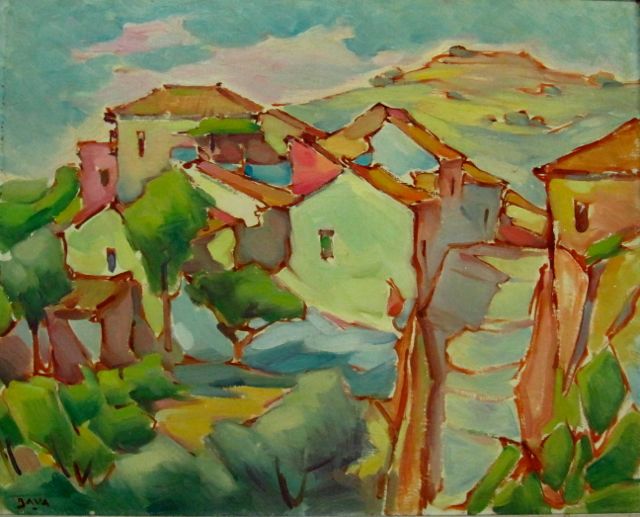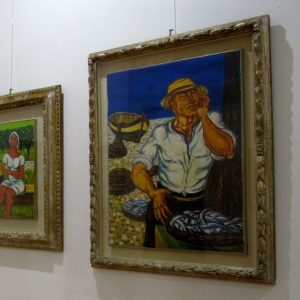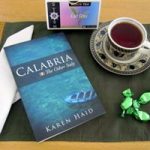Intriguing, eclectic, thought provoking – a few words I would use to describe the Palazzo della Cultura, a new museum in Reggio Calabria that is definitely worth the visit.
Not only do the various collections have merit in their own rights, but the art is also important for what it culturally represents to the people of the province.
CULTURAL HERITAGE AND LEGALITY
Approaching the entrance to the Palazzo della Cultura and reading the brass plaque out front, I was confronted with the concept of culture playing a role in the defense of legality:

Palazzo della Cultura Pasquino Crupi
Province of Reggio Calabria
Presidency and Department of Policies and Cultural Planning
Cultural Heritage – Safeguarding Legality.
In addition, the Palazzo della Cultura has been named after Pasquino Crupi (1940-2013), writer, journalist, teacher and staunch meredionalista, or scholar of cultural traditions and economic issues in southern Italy.

Palazzo della Cultura Pasquino Crupi, Reggio Calabria
The building itself has had a significant past, most importantly for the many years it served as a home for abandoned children. Today, the vast exhibition space – over 4,000 square meters or 43,000 square feet – hosts a diverse range of collections. Amongst the museum’s more than 400 paintings are those confiscated from a local mafia boss and a group focusing on the work of artists from Calabria.
A large area is also dedicated to local artists, and there are two somewhat unexpected displays: an exhibition of old (but I was assured, still working) gramophones and a substantial model train exposition. And finally, or perhaps to begin with as it fills the ground floor, the San Paolo Museum, a fine collection of religious art and other objects amassed by a local priest. The Palazzo della Cultura also plans to have a section dedicated to the city’s one and only bergamot fruit in the near future, and there is a hall that is actively used for lectures and concerts, as well as a library.
CONFISCATED ART OF A ‘NDRANGHETA BOSS

Confiscated ‘Ndrangheta art in the Palazzo della Cultura
When the Palazzo della Cultura opened in May 2016, the publicity hype was centered around the 124 paintings formerly owned by the ‘Ndrangheta mafia boss Gioacchino Campolo and sequestered by the state when Reggio Calabria’s “King of Video Poker,” as he was called, was incarcerated. I had seen the works a few years earlier in a temporary exhibit at Reggio’s Archeological Museum when that institution was completing its renovations.
The confiscated art collection boasts several big names, most authentic, some definitely unauthentic and others still being studied for verification. So as the young women who take visitors around the museum point out, even criminals can be swindled. For the viewer, the undoubtedly forged and possibly dubious paintings are separated from the genuine works, and I suppose the fakes hold their own cautionary tale.
What is the value of these paintings? Perhaps considerable, but the thrust of the museum is that for the people of the province, whatever monetary figure may be placed on the collection, the ethical and moral value is higher. Chalk one up for legality.

Giovanni Cappelli (1923-1997), Figure of a Woman, 1985, oil on canvas, 100 x 130 cm
A FEW IMAGES FROM THE PALAZZO DELLA CULTURA

Crucifix, Italian School, 17th-century, ivory, 40 x 22 cm
While the confiscated collection leans heavily on the twentieth century, a few earlier religious pieces, such as this graceful 17th-century crucifix in ivory, count amongst the works. As for the many modern paintings, the artists range from regional to national and international fame.

Pietro Annigoni (1910-1988), Face of a Woman, Second half of 20th-century, sanguine on paper and board, 39.5 x 29.5 cm
I like seeing works by artists from the area, such as the images of laborers by the Calabrian realist painter Nunzio Bava and the Sicilian expressionist Giuseppe Migneco from nearby Messina.

Nunzio Bava (1906-1994), I Lavoratori (The Workers), 1936, oil on canvas, 87 x 65 cm
While most of the artists are Italian, such as Giorgio De Chirico, Antonio Ligabue and Lucio Fontana, a couple high-profile international names, such as Salvador Dalí are included in the collection.

Salvador Dali (1904-1989), Source of Life, 1988, Painting on ceramic tile, 40 x 30 cm
THE CALARCO COLLECTION
As I mentioned above, I enjoy seeing works by Calabrian artists, particularly their interpretations of locations with which I am familiar. The Palazzo della Cultura’s Calarco Collection, housed on the third floor, stood out in this category.

Benvenuto Greco, Calabrian Landscape, 1980, oil on masonite, 45 x 61 cm
A number of paintings by Nunzio Bava (1906-1994), whose “I Lavoratori” is pictured above, caught my eye. Born in the town of Bagaladi, now part of Reggio’s metropolitan area, he is considered to be Calabria’s most important 20th-century realist painter and his religious compositions can be viewed in several churches in Reggio, most notably in the city’s cathedral.

Nunzio Bava, Calabrian Village, 1958, oil on masonite, 60 x 75 cm
The many canvases were full of classic Calabrian images of villages, the dramatic seaside and even the legendary Fata Morgana, the optical illusion found in the Strait of Messina between Calabria and Sicily that makes the coastline appear closer than it is.

Massimo Casciano (Casmas), Sky, Earth, Sea, 1964, oil on canvas , 50 x 60 cm

Santina Orrico in Falvo, Awakening of the Fata Morgana, 20th-century, print on canvas, 77 x 52 cm
Amongst the many works by local artists, Alessandro Allegra’s “Riflessione di una vita” (Reflection of a Life) drew me in.

Alessandro Allegra, Reflection of a Life, 2015, acrylic on canvas
VISITING THE PALAZZO DELLA CULTURA

Giueseppe Migneco (1908-1997), Fishmonger, Second half of 20th-cent., oil on canvas, 70 x 55 cm
The museum is spread out over three floors and there’s even an excellent view over the city and the Strait of Messina across to Sicily from the balcony. A cloud cover enveloped Mount Etna that day, so I will have to return for another visit to the galleries and for hopefully the perfect view of the famous volcano. And although I also spent time in the Museo San Paolo that day, I will leave that description for another blog post.
The Palazzo della Cultura is big and there’s more than you might expect, so plan your visit accordingly as the museum is closed for a long lunch, with opening hours of 9:30 – 1:00 and 3:30 – 6:00 on Tuesday through Sunday (telephone 0965/890623). As for directions, it’s located at Via E. Cuzzocrea, 48, a relatively short walk uphill from Reggio’s landmark Aragon Castle. On certain days during the summer tourist season, there has even been a free shuttle bus available from the Archeological Museum, so that may be worth the inquiry for sightseers who will certainly be visiting the famous Riace Bronzes when in Reggio Calabria.
And did I mention? It’s free!
 Read more about what there is to see and do in Reggio Calabria, the beautiful city right at the point of the toe in the Italian boot, as well as daily life, history, culture, art, food and society in this fascinating southern Italian region in my non-fiction book Calabria: The Other Italy. Available in paperback and electronic versions.
Read more about what there is to see and do in Reggio Calabria, the beautiful city right at the point of the toe in the Italian boot, as well as daily life, history, culture, art, food and society in this fascinating southern Italian region in my non-fiction book Calabria: The Other Italy. Available in paperback and electronic versions.
Visit Reggio on one of my Calabria tours!


Comments 10
Excellent piece. Thank you karen
Grazia
Author
Thanks! And I appreciate your stopping by my blog.
A very enjoyable museum tour …….. and I didn’t have to leave the comfort of my chair!!
I also was quite taken with the “Reflection of a Life” portrait. There seems to be quite a story contained within it!
Grazie!
Author
Yes, as though he may have just walked out of one of the local landscape paintings… Thanks!
There is an actual Italian word for a “scholar of cultural traditions and economic issues in southern Italy” — wow! Regarding the fraudulent artwork, I once read an article that stated that most museums contain many of these which they had at one time thought to be genuine and as technology allows them to reexamine the pieces, curators have had to change out the accompanying placards identifying the supposed artists. From your photos I love that first landscape done by a local (gorgeous green landscape) — I wasn’t sure if it belonged to Nunzio Bava or Benvenuto Greco?
Author
Yes, that’s a description of the meaning as it would be hard to find one word in English for the concept. Meridione is the south. Your comment about the fraudulent artwork in museums is interesting. I wonder what the overall percentages would be – a very hard number to come up with as they’d have to stop and reexamine everything. The green landscape is by Benvenuto Greco as indicated in the caption. I like it, too, as it brings together the different levels of terrain from the flatter agricultural area to the jagged hills and the mountains looming in the background.
Thanks Karen! Regarding the fraudulent artwork, according to a 2010 article in the Independent, almost 20 percent of exhibited and vault pieces in the UK may be assigned to forgeries. I assume the numbers vary somewhat with other countries.
Author
Wow, interesting!
Hey Karen not much a fan of modern art but the local artists do intrigue me. Bavas work is so lifelike it stood out as the best as did the green coast painting.
Question.
Why did you pick to search Calabria over Sicily Campania Sardinia Puglia etc?
Most people always bypass Calabria but are skipping the most unique and varied part of Italy as rich or more in history,lore, amazing scenery , mountains as any other place in the Mediterranean.
Thanks again Karen for bringing to the fore the unique beauty of hidden Calabria. Almost Every town every hill valley plain and mountain tell a story in Calabria. Even a German traveller historian i forget his name said Calabria is even more varied and interesting than Sicily. Thats saying alot.
Keep up the awesome work.
I know it would take years to comment on every corner of Calabria. Thats how much there is packed into compact small calabria. The history culture and forbidding mountains make calabria bigger than it is in actual physical size.
Did you know there is a group of postglacial millenium aged oaks in the Aspromonte mountains..i read about it the other day.
In Nardodipace in central calabria there’s huge granite rocks piled up like a stonehenge? Check it out..its intriguing.
Huge monoliths near san luca the big one is Pietra Kappa.
Then theres ancient Armenian presence in Bruzzano Zeffirio “rocca armena” or the “dolomites of the south” in Canolo, the ghost town of Africo..the incredible rocky crystalline mountains around Stilo. Then we got the Tropical Mango Plantations around Catona and Annona Cherimoyas around Reggio and Papayas further south.
I can go on and on lol.
Sorry for the rambling
Author
Yes, Jim, it is truly amazing how much diversity and how many jewels are packed into a relatively small piece of land, from the geological to the world of nature, the people and their culture. It could take a lifetime to visit and write about every one. Thank you for your suggestions and your enthusiasm. I happened to land in Calabria with a job teaching English, so that’s how my journey of discovery began, purely by chance, or maybe it was fate…